Spices of dry and fresh drizzles
The girl, who knew the article about yeasts "Research of thermoresistance and antagonistic powers of yeasts of Saccharomyces cerevisiae"
Research on thermoresistance and antagonistic powers of yeasts in Saccharomyces cerevisiae
The choice of antagonistic authorities of some bacteria for the suppression of others (pathogenic) was bred for a long time of rich fates, even though little respect was attached to the achievement of such authorities of yeasts.
It has been established that the difference between the metabolites of yeast and yeast cells on gram-negative and gram-positive microorganisms is different: live cells of yeast are the most antagonistically active against gram-positive microorganisms, and their metabolism - by introduction to gram-negative.
Entry
The basis of molding the quality of bread is the composition of folded syrovina for microorganisms and enzymes, which are either present in the prescription components that are processed, or specially vikoristan in the technological process. So that the quality of the bakery sprouts lie in the bakery authorities of boroshna, drіzhdzhіv, іnshої syrovini, and will change them into carbohydrate-amilase, protein-protein and lipo-lipase complexes in the course of the technological process, as well as in the living organisms
In the rest of the hour, the tendency to increase the supply of boars with low bakery authorities has now increased. The bakery and bakery mills recycle wheat borosno, chemical warehouse and the sameness as it kolivaetsya in different parties. Tse vplivaє, in pershu cherga, on the power of bakery products, the intensity of the penetration of the column, biochemical and microbiological processes in the preparation of the test, and that was done, and, zreshtoyu, for demonstrations of the quality of ready-made virobiv.
The development of the possibility of infection of antibacterial infections, which are seen by yeasts, is at an early stage of development. Antagonism of drіzhdzhivs in relation to different microorganism ties in the first black with the fight for the life of speech in the middle. Vin manifests itself as a change in the pH of the medium due to ion exchange synthesis organic acids, the occurrence of high concentrations of ethanol, the sighting of antibacterial spoluk and kilernyh toxins in Vіdkrittya antagonistic powers of the spirits to know a wide zastosuvannya in rich galuzahs, such as a grub industry, the silske state, medicine, veterinary medicine, health care.
It is important that the death of the yeast begins already at 45-50 ° C, and at 90-95 ° C the stench will die again. However, according to the rest of the literary tribute, the cells of the tsukromitsets at such temperatures are not more likely to perish, but rather take sublethal losses and spend building up to growth on the life-giving centers. Therefore, the number of clitins is right food products may be underestimated.
Meta roboti
The study of thermoresistance and antagonistic activity of S. cerevisiae yeasts and their metabolites in relation to different groups of microorganisms.
materials and methods
Objects due
The study of antagonistic powers of yeast metabolites was carried out baker's drіzhdzhіv S.cerevisiae:
Pressed drіzhdzhi TM "Lvіvskі drіzhdzhi";
Pressed drіzhdzhi TM "Krivorіzky drіzhdzhi";
Dry active yeast TM "Saf-Levyur";
Drіzhdzhі, vidіlenі z bread, baked in laboratory umová іz vіstom drіzhdzhіv 2.4% per recipe;
Drіzhdzhі, vidіlenі іz khіba on hop sourdough;
Drіzhdzhі, vidilenі z loaf "Niva", іz vіstom drіzhdzhiv 1.5% per recipe;
Drіzhdzhі, videlenі z loaf "Kievskiy", іz vіstom drіzhdzhіv 3% for the recipe;
Drіzhdzhі, vydіlenі іz grain bread "Molodist", a kind of baking on grain sourdough without drіzhdzhiv.
To determine the quality of dry yeast, the bread was vicorated at the temperature of boiling bread: bread with 2.4% of pressing and 0.8% of dry yeast; and 3% of drіzhdzhіv, m'yakush was brought into the tea leaves.
Zamis test and molding of samples of laboratory specimens was carried out manually. The temperature of brewing is 200-220 ° С, the hour of brewing is 40-45 minutes.
To mark the number of live yeast cells at the bread from the trading line, the following signs were celebrated:
Bread of life without yeast on hops TM "Life Force".
To determine the antagonistic power of yeasts, their metabolites, beverages and bread, the test cultures of the Museum of the Department of Biotechnology and Microbiology were carried out: 7, Aspergillus niger P-3.
Methods of microbiological studies
To reveal the antagonistic powers of the yeasts behind the established zones of the growth of test cultures, the method of perpendicular strokes and the method of paper disks were used.
Method of perpendicular strokes. The media (wort-agar, Sabouraud, HCA, peptone-glucose yeast agar) were poured near a Petri dish and the doba was incubated in a thermostat to check the microbiological purity of the media. Along the entire length of time, the cups hung in a succulent line, one of the last zrazkiv drizhzhiv. A stroke, perpendicular to the line of growth of the yeasts, starting at the periphery of the dish, was applied to test cultures. Petri dishes were shaken in a thermostat at 30°C for 3 deb. Test cultures (S. aureus, E. coli, B. subtilis, E. cloacae) were vicorified with the same species.
paper disc method. Breeding races of baker's yeast S. cerevisiae at a quantity of 3% were added to 750 ml flasks from 150 ml of sterile revitalizing medium (NaCl 0.5%, glucose 5% per 1 liter of water). Cultivation was carried out by stretching for 48 years on goydals (320 rpm) at 30°C. Samples were centrifuged to remove the supernatant (active metabolite) and sediment fraction (clitiny yeasts).
The test cultures were hung in a succulent lawn for the middle of Sabouraud. Then, on top of the sowing, sterile disks of filter paper were installed, soaked in biological samples (adjustment and siege soil). Incubated at 37°C twice at room temperature. After that, the growth of test-cultures was carried out by measuring the diameter of the stump.
Reinvention of sublethal earworms. Finished bread slices were cut into navpils and the pulp was sown in 10 g. Half of the pulp was added to 45 ml of malt broth, and the rest was added to malt broth with additions of NaCl. Cultivation was carried out for 24 years at a temperature of 30 ° C. Samples were taken for 4, 18 and 24 years of cultivation in a quantity of 1 ml with an advance sowing in the clay method on wort agar and malt agar mediums. The middle was treated with the antibiotic streptomycin. Petri dishes were placed in a thermostat and observed at a temperature of 30°C; .
The results of that discussion
In the past, as micro-organisms are subject to environmental stresses, such as high or low temperatures, okremі clitiny otrimuyut metabolic deficiencies and, as a result, become undelayed to form colonies on selective living media. At the same time, non-poshkodzhenі kіtini can be tolerant. To this end, for the recognition of the poshkozhenikh clitin, there are special invigorating mediums.
Sublethally susceptibility to micro-organisms during the stages of growth, increased sensitivity to various agents of the selective vitalizing medium, susceptibility to membranes, DNA and enzymes in the tricarboxylic acid cycle, ribosome disruption. The loss of ribosomes and cell membranes is manifested as the most obvious consequence of the loss of high temperature.
Therefore, at the first stage of the work, in order to increase the capacity of dry yeast cells to survive at the temperature of boiling bread, the tea leaves were boiled (with the addition of 1% hop brew), m'yakush were added to the yakush of the last grains of bread, baked without other railway, 3% them. The tea leaves served as a life-giving medium for sublethal earworms.
It should be noted that during the microbiological analysis of brews and bread before the cob, they did not reveal the presence of yeast cells.
In the course of the experiment, it was established that after 24 years, the fermented tea leaves with the introduction of m'yakush from yeast-free bread did not avenge the life of the living creatures of the yeast. Vaughn may receive a honey smell, a sign of wandering and contamination of the day.
In zavartsі with bread, which was added 1, 5% and 3% of yeast to borosh, their quantity was 1 × 102 and 1 × 103 KUO / g in total. In the first place, it was noted that there was an unacceptable rotten smell and third-party microorganism, a slight increase in general, which is evidence of the cob of wandering. Another thing is the smell of alcohol, and the tea leaves were full of brooding in the afternoon.
The next stage of the work on the introduction of sublethally poshkodzhennyh klitin drіzhdzhіv was the victoria as a medium of malt extract, which was brought in by the m'yakush of bread with distant vitreousness in the new stretch for 3 years. Potim 0.2 ml of the final suspension was hung on the wort-agar medium. Like zrazki vikoristovuvali bread, vypecheny z adding 1, 5 and 3% of pressed yeast to the mass of borosna.
It has been established that in the pulp of both grains of bread there is 1-2 KUO / g of yeast. Analyzing the results, it was a little lethal, that the hour of the glass of the last spicy bread in the malt extract was not sufficient for the renewal of the sub-lethally poshkodzhennyh clitin of the drijzhiv. This led to an increase in the vitrivality of the crumble of the last pieces of bread until the age of 24, with the upcoming selection of samples after 4 and 18 years.
After 4 years of vitrification of bread in malt extract, the growth of clitin yeasts on wort-agar was not detected. Analysis of the results of follow-up studies after 18 years showed that after hanging 1 ml of suspension from the first batch of bread, prepared with the addition of 1.5% of yeast on wort-agar, it grew 2-4 KUO, and from another ) ) - 6-8 deyako. Microbiological control of the remaining objects after 24 years of cultivation showed that the number of yeasts on Petri dishes became evidently 3-5 CFR and 8-9 CCR.
To check the heat resistance of dry, creamy bread, baked in the laboratory, baked in the laboratory, baked bread, pridbnі near the merezhі (Figure 1.).
Figure 1 - Smіst drіzhdzhіv v hlіbі іz trade ї merge
The analysis was carried out showing that the largest number of live clitins of yeast was found in the Kyivskyi loaf, from the mixture of pressed yeasts 3% per recipe, baked in a safe way. The smallest quantity is in bread prepared on hop sourdough. The bread was victorious as soon as it was cooked.
It should be noted that the follow-up was carried out together with the droughts at the bread of industrial production in 24 and 48 years. life savings for children were not shown.
When microscopically seen sprouts of yeasts, as if grown on wort-agar, it was revealed that the stench may be significantly smaller in size, lower in size tsukromyceti (Figure 2).

Figure 2 - Porіvnyannja razmіrіv vіdіlenіh drіzhdzhіv: 1 — drіzhdzhі, yakі vyavlennі na loaf "Niva", 2 - drіzhnі, yakі vіvlenіv іn podіlії "Kiїvskiy", 3 - Saccharomyces cerevisiae
Drijdzhi, seen from bread on hops, scoffed at their cultural signs, shards of their colonies were white, but creamy in color, and clitins under a microscope were small enough great roses(Figure 3).

Figure 3 - Drіzhdzhi, seen from bread on hop sourdough
Conducted studies on the identification of species affiliation, for morphological and cultural and physiological and biochemical signs of fermentation in carbohydrates confirmed that all yeasts seen from different varieties of bread are considered to be S. cerevisiae (Table 1)
Table 1 - Fermentation in carbohydrates in the form of yeast

To stifle the growth of bacteria short inspiration drіzhdzhіv to malt extract it is recommended to add strength to the amount of 10% of the total commitment. As a result, the bread was victorious, boiled in the laboratory with the addition of 2.4% pressing and 0.8% dry yeast.
Like NaCl, vicorist is like a grub preservative. The strength of zdatna іngіbuvati іngibuvati zrostannya bakterіy: kіtin's cobwebs pіdєtsya plazmolyzu, scho pіnіchuє її її її sprostannya, and then і zovsіm gyna. Inhibiting effect of salt deposits due to pH value. More marine bacteria at 20% or induce a lower concentration of NaCl, which, like fungi and yeasts, tolerate a higher concentration, or in some fluctuations, it is a stimulant for the growth of clitin. Strongly nadaє zahisny vpliv on microorganism microorganism following a decrease in water activity (aw) and an increase in the thermostability of microorganism behind the mechanism, which is similar to drying.
At the end of the manifestation of live clitins of yeasts, bread was victoriously baked, boiled with additional pressing of 2.4% of dried yeasts, with further vitreousing of yoga 1.5 years in malt extract with additional salt. On the Petri bowl were seen 14 DESHE drіzhdzhiv. Colonies of isolated clitins of yeasts were sown in erysipelas color, small even surface, regular edges (Figure 4).

Malyunok 4 - Colonies of yeasts, seen from baked bread in laboratory minds
Significantly, the fact that the introduction of the poshkozhennyh clitin drіzhdzhіv, yakі vytrimuvalis in the malt extract with the addition of salt, began to be doubled, lower without the introduction of NaCl.
In bread, baked with the addition of 0.8% dry yeast in the borosna mass, klitin dryzhzhiv, buv. Ymovіrno, tse pov'azano with a small vіdsotk of drіzhdzhiv near the bread.
In order to reconsider the building of yeast cells to survive at the temperature of boiling bread, and as a result of their heat resistance, they took out the advances of bread, near the baths in the trade store:
Zhitn_y yeast-free whole grain bread TM "Milvil";
Bread of life without yeast on hops TM "Life Force".
In the course of the experiment, sublethally poshkodzhenykh kіtin drіzhdzhiv saw bv. Drіzhdzhi in tsikh zrazka appeared unstable to high temperatures of boiling.
At the initial stage of the work, the antagonistic dominance of S. cerevisiae yeasts and other metabolites of other test cultures was determined by the method of paper discs on Sabouraud's medium (Figure 5).
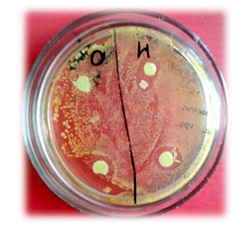
Malyunok 5 - Zoni zatrimok growing test cultures: 1 - St subtilis; 2 - E. cloaceae
As a matter of fact, the press of dry yeast trademarks "Krivorizky Drіzhdzhі" TOV "Lesaffre Ukraine" and "Lvivskiy Drіzhdzhi" CJSC "Company Enzim", dry active yeast TM "Saf-LEVYUR" and dry, yakі khіmіli z.
Dried plants were cultivated with medium glucose and NaCl for 48 years. Samples were taken at 6, 24 and 48 years of cultivation (Table 2.).
Table 2 - pH values of the past samples of yeast suspensions
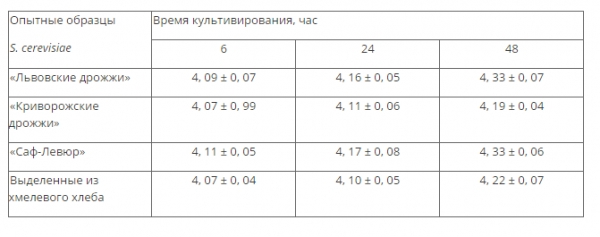
It should be noted that S. cerevisiae had little antagonistic activity when applied to all test cultures, inhibiting the growth of E. sloaceae called S. cerevisiae, on the basis of which dry active yeasts were prepared. The degree of antagonism severity was low and medium (Tables 3, 4.).
Table 3 - The value of the diameter of the growth of the test cultures for pressing the yeast

Table 4. - The value of the diameter of the growth of test cultures for dry and dried bread
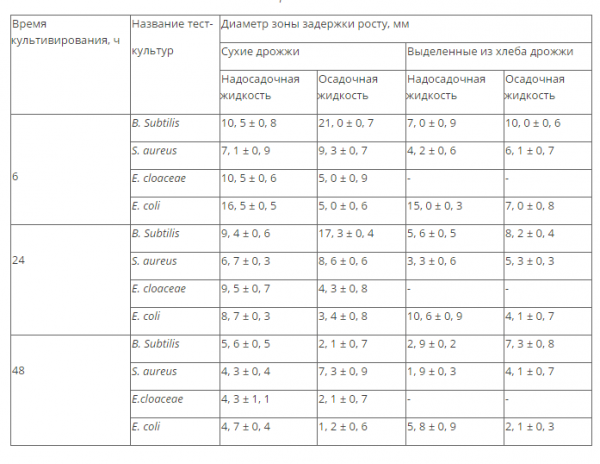
Pressed yeasts of both trademarks may have the same antagonistic activity when applied to test cultures. It has been shown that races of baker's yeasts do not cause the growth of E. cloaceae bacteria, which, at times of high concentration in the human body, negatively affect the state of health. Clitini yeasts and their metabolites are differently injected into gram-positive and gram-negative bacteria. The greatest activity associated with the growth of test cultures, the pressing of yeasts, was observed at 6 years of cultivation, 48 years of cultivation was characterized by a significant decrease in the activity of both living cells of S. cerevisiae and its metabolites.
Although dry yeast and dry yeast, seen from bread on hop sourdough, dry yeast may be more antagonistic to such test cultures as B. subtilis, S. aureus and E. сloaceae. When compared to E. coli, the activity of mayge is the same in both cases. The largest growth diameters of test cultures fall on 6 years of cultivation.
The most active antagonists are dry yeasts and their metabolites. Zones of growth of test-cultures, adopted by these yeasts, significantly grow in others. Also, as can be seen from Tables 3 and 4, living cells of yeast and their metabolites differ in different ways on gram-positive and gram-negative cells in all subsequent samples of baker's yeasts.
Thus, for gram-positive test cultures of S. aureus and CT subtilis, the greatest antagonistic activity is shown by living cells of yeasts at 6 and 24 years of cultivation. Imovirno, it is related to this, that in the course of its life, the yeast of the building viroblyatsya speech with antimicrobial activity (bacteriocin) and vibrating the life of microorganism for the cancer of cancer.
The antagonistic activity of sedimentary and supernatant fractions of S. cerevisiae by growing to E. coli was the highest during the period of culture growth decrease, so that metabolites were added to gram-negative cultures, which resulted in the death of yeast cells. Ale antagonistic activity was weak, and most of the E. sloaceae from the side of the pressed yeasts inflamed during the day.
Otzhe, lіzovanі kіtinі drіzhdzhiv see in the middle biologically active speech and low molecular weight products of vitality, such as hydrolytic enzymes, non-reductant storage of speech, accumulated toxins and other products of metabolic metabolism, which can inhibit the growth of bacteria. Diagnosis of yeast metabolites and lysis of yeast cells on gram-negative and gram-positive microorganisms. Therefore, lizati cultures of drіzhdzhіv are promising material for further research.
Visnovok
- Otrimani results testify to the possibility of clitin drіzhdzhiv being overwhelmed with life in the bread after high temperatures of boiling on them.
- It has been shown that the use of cells of drіzhdzhіv, vidilenі z different commercial forms, producing biologically active speech and low molecular weight products of їhnої zhittєdіyalnostі, yakі zdatnі prinіchuvati zrostannya gram-negative and gram-positive microorganism.
- It was revealed that the most active antagonists in relation to analysis of test cultures of S. cerevisiae from dry yeasts.
- Alive cells of yeasts, as they were seen in dry commercial form, show antagonistic activity in relation to gram-positive microorganisms in 3 times more, and metabolism - in two times more in relation to gram-negative, compared with pressed yeasts.
I promise that you will have the most favorite pies of yours and your children. Because the stench is more savory, smelly. And it's easy to prepare them.
Pour one full glass of warm (30-40 degrees) water into a bowl. Add 2 tablespoons of zucru and two teaspoons of dried fruits (the quantity of dried dried fruits is approximately 10-11 grams, you can replace with 50 grams fresh drizzle). Mix up the yeast and zukor and fill in their whilin for 15. In order for the yeast to come to life.
Let's drink a teaspoon of salt and mix it well. 
Potim visipte into a bowl three equal bottles of borosna. Povna flask - the whole flask, in a kind of borosno sipane without a top, aligned with the edges. Breathe in the water and in the same flask, but do not forget to hang the flask, first sip in it boroughly. 
With a hand on a stake in the edge to the middle, start to mush quietly. As only a greater part of the boroshna zmіshaєtsya with the motherland - pour in the olive. 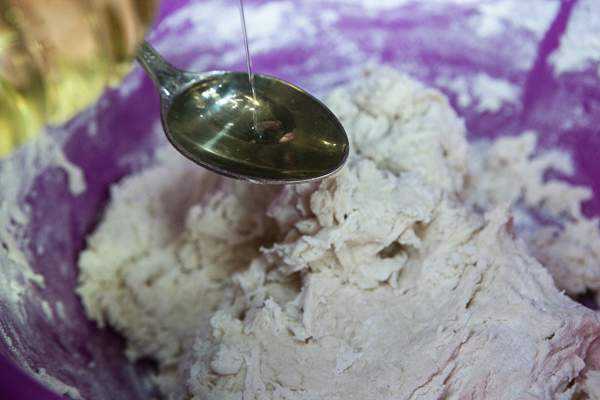

And mix it up tightly until I become uniform. 
Cover it tightly with a towel with a towel (to save it from breathing) and put it on 45 quills. It is not necessary to put the dough in a warm place and soak as if to speed up the process in a special way. Sufficient room temperature.
After 45 minutes, lay it down on the table and remember it well. Press it down with your hands and immediately jump into the sack. 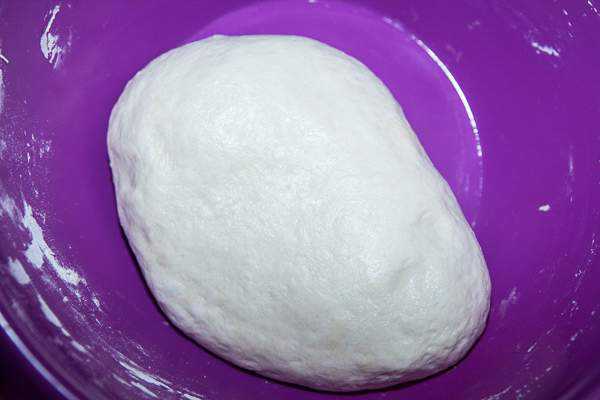
Turn the dough into a bowl, cover it and set it aside for a year, so that there is enough left.
While it's still rising, prepare the filling.
Peel the apples from the skins of that nasinnya. 
Break with small skibochki. Transfer to the pan.
Add zukor (3 tablespoons) and a pinch of butter to the apples. 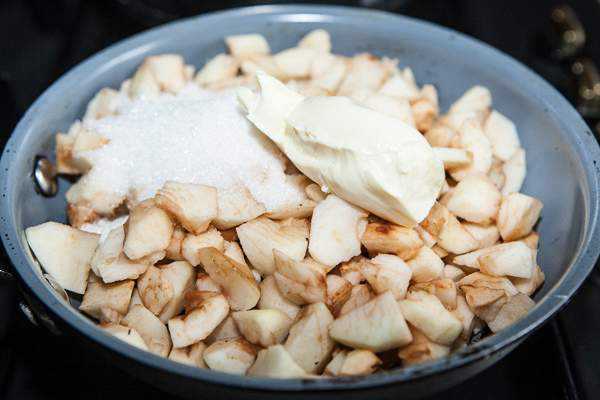
Put the frying pan on the fire troch more than medium. 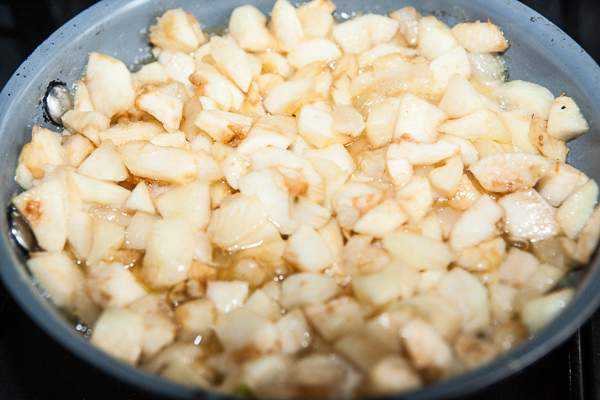
Simmer the apples on the fire, periodically stirring it carefully, trying to save the little things, and not turning them into mashed potatoes.
Approximately 10-15 quills.
Let's sweat the cinnamon and mix it up. 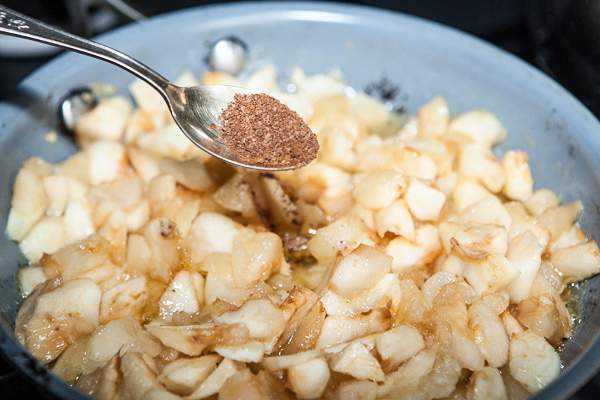
Tomіt sche kіlka khvilin, until that moment, like a motherland, scho on the cob settled into olії, tsukru i apple juice do not thicken and do not evaporate. 
Take the pan out of the fire and let the filling cool down a little. 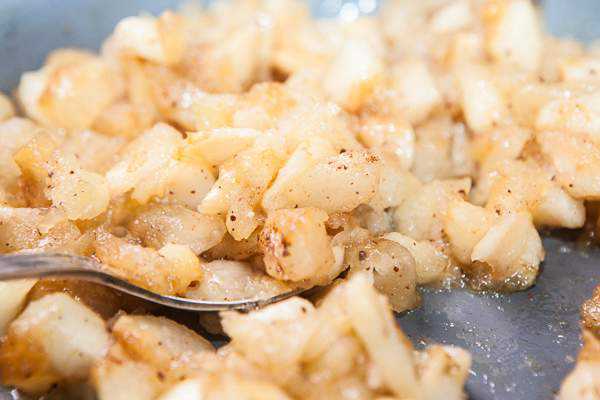
Cooked in this way, the apple does not darken at the beginning and does not wilt when boiled.
Quietly, what happened, put it on the table. You can smear stіl with a drop of olії. 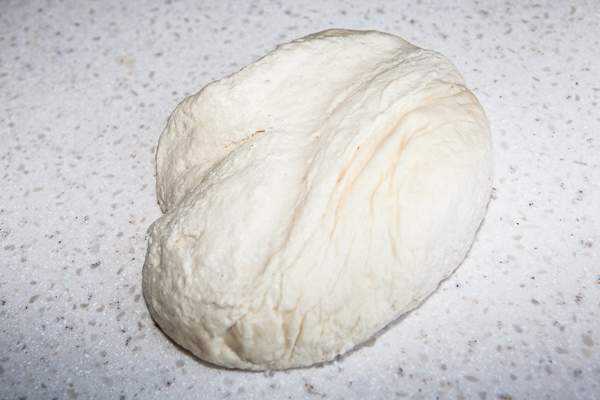
Divide the dough into 10 or 12 pieces of approximately the same size. 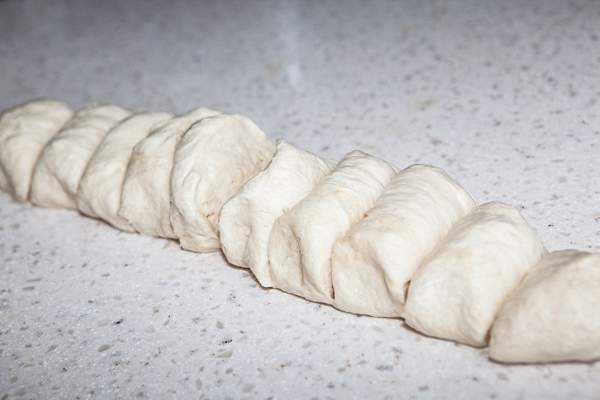
Download leather shmatochok in a sack. 
Let's take the dough balls one at a time.
Roll them with a rocking chair into a cake with a diameter of 13-15 centimeters. 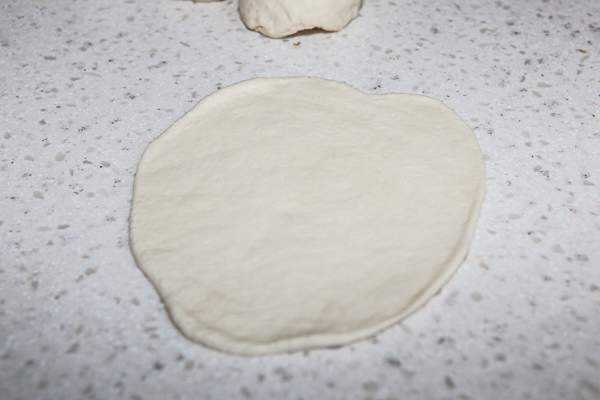
Gently cut off the edge of the dough with a pivkol for embellishment. ![]()
In the middle of the shortbread itself, place a tablespoon with hot stuffing. ![]()
Let's close the two edges of the troch with an overlap. 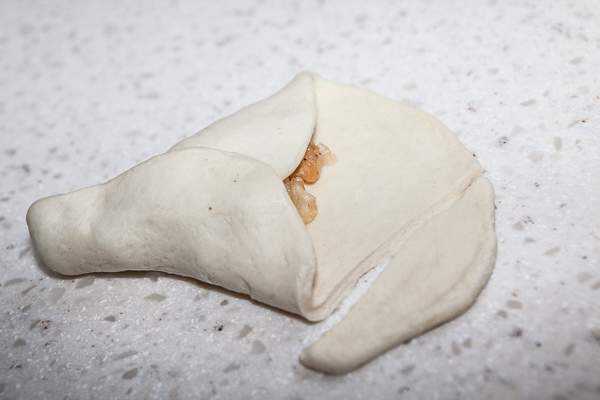
And move the third edge to the center, even with a margin of a centimeter, so that you have a wiyshov trikutnik. 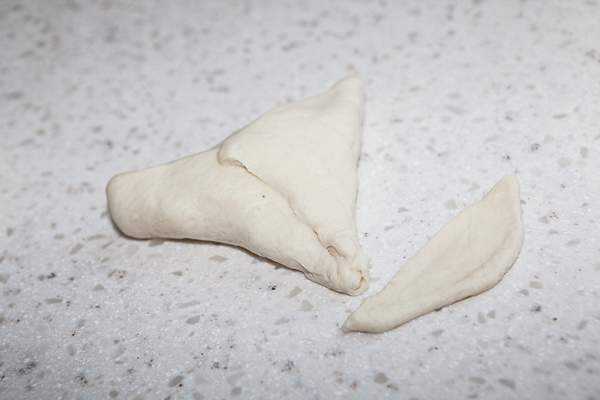
Cover the sheet with baking paper.
Turn the pie over on papyrus, so that the pidgin's hands are slumped at the bottom.
From the torn little piece of dough, which is left over, for the help of a knife, open a leaf.
Make a bunch of short incisions from both sides of the dough, and then one in the middle. 
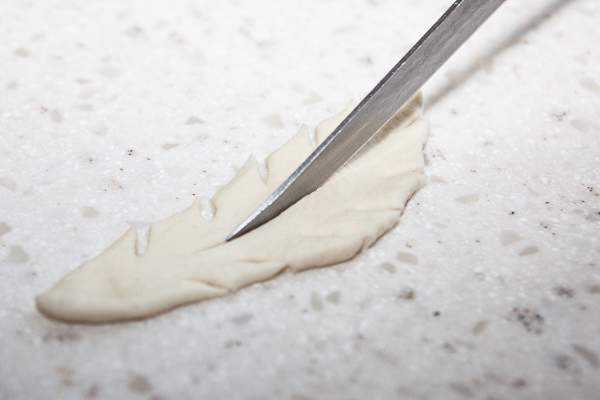

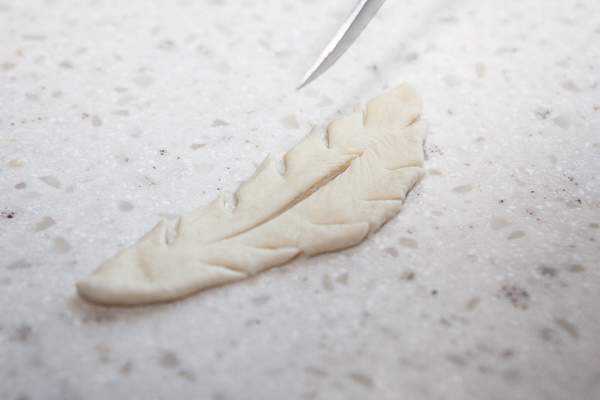
A leaf, which is wiyshov, is placed on top of a tricot pie on an angle. 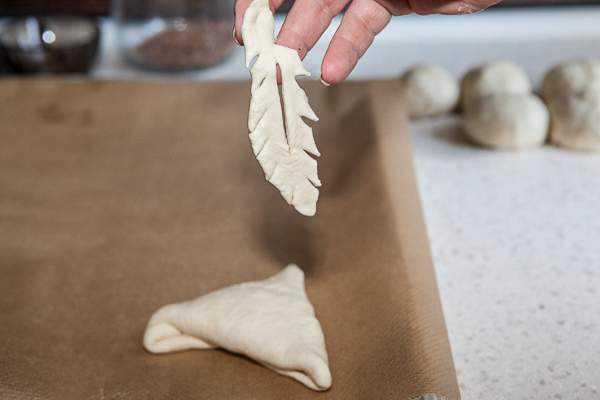

So form the pirіzhki yourself, which are left out. 

Prepare the patties on the deck for a residual brew for 25 quills.
Tse duzhe important moment! If you don’t let the pirіzhki do well in front of the vipіchkoy, then in the oven the stench can crack, wear out the shape. Until then, they will be insufficiently soft in the finished look.
Bazhano cover them with a towel with a towel for the whole hour.
Don't forget to turn on the oven and preheat the oven to 220 degrees. It is necessary to turn on the oven less than 15 minutes before the spadix.
Beat the egg into a bowl. Give me the same amount of cold water. And spread it well. 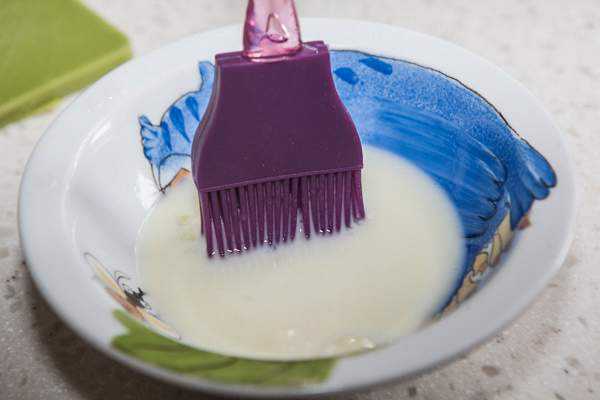
For the help of a penzlik, make pies, which you already stood. 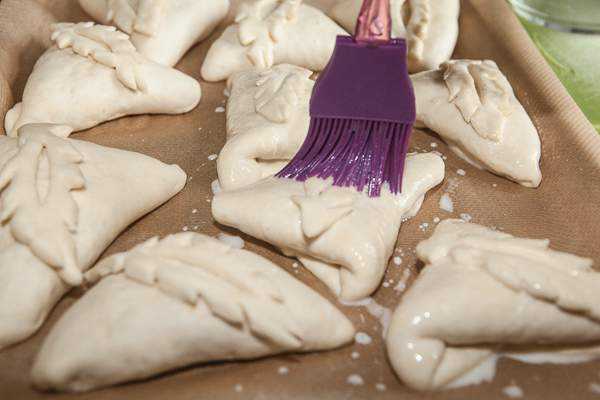
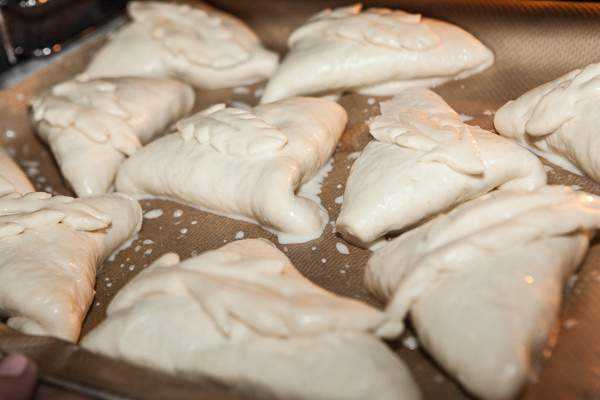
Put a sheet with pirozhki in the oven (in the middle of the police in the electric one, and on the top near the gas stove). 
Whip for 10-15 breaths|minutes|. 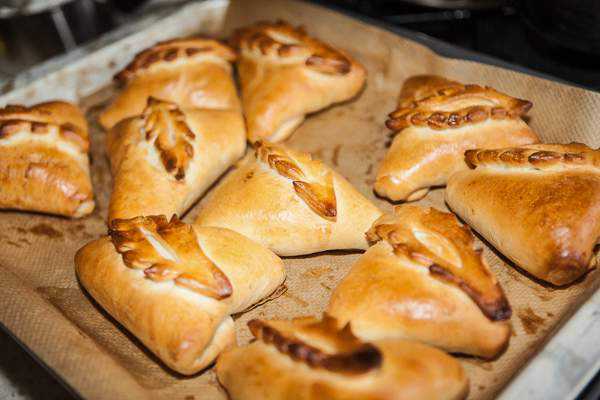
When preparing pies, let the sprat of chwilin cool and serve warm at the table. 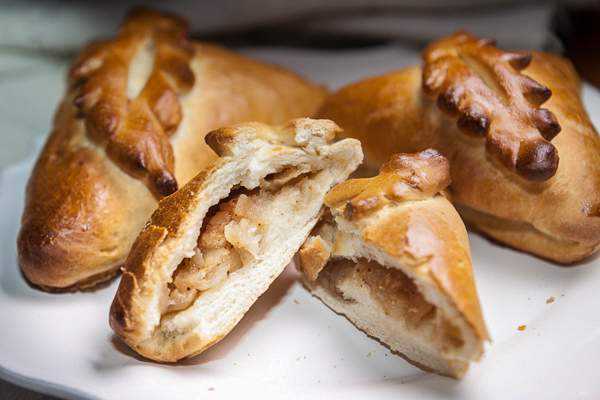
100% new yeast = 40% active dry yeast = 33% dry dry yeast (instant). 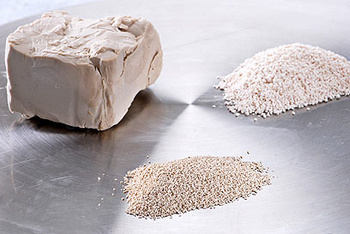
In other words:
☺-multiply the number of swedish yeasts by 3 for an equal number of fresh ones.
☺-multiply the number of active dry yeasts by 2.5 for an equal number of fresh ones.
☺-multiply the number of dry dry yeasts by 1.25 for an equal number of active dry yeasts
For the formula see G. Kutova (http://forum.good-cook.ru)
◘
62 g of new yeast are added to three sachets of 7 g (21 g) of dry active. One sachet 7 g = 2 1/4 teaspoons of dried yeast.
10g wet = 3.5g dry
Exit approximately 9 UAH. live yeast \u003d 1 tsp dry
◘
50 g "sirih" = 1 sachet of "sweet".
◘
Proportion of change syrich drizhzhiv dry:
7 g of dry dried fruits - 1 teaspoon or 0.5 tablespoons of dry
10 g of dry drizhdzhiv-1.5 tsp or 0.75 dry
13 g of sirih drіzhdzhiv-2 teaspoons or 1 tbsp. spoon dry
Conversion of dry dredges to fresh pressing
When preparing the brew, make sure to drink the food, put some more dry yeast in it, and replace the fresh pressing with some amount of dry yeast, as it is not indicated.
Fresh drіzhdzhі - like a breeze, what good stink?
Fresh drizzle is more plastic, but not sticky, and not sticky on the fingers. And they pluck in layers, like a good housewife. Only the sir of the planet is large, but the dry ones are small. When broken, the frills of the drizzle "creak" on the fingers.
The color scheme is gray, with streaks of different tones, and more of a yellowish-brown color, more drіzhdzhі not fresh.
Obov'yazkovo savage respect for the cloaks of clothes, the stench is guilty of absolutely the same, as the main mass of the entire "cube" of drіzhdzhiv. Like the stench of the wind, also not fresh.
And the smell of fresh, non-lying drizzles cannot be confused with anything.
It smells "hostro" and "bread". If there is malt in the smell, or it just smells unpleasant, don’t take it better.
Fresh (pressed) and dry yeasts are interchangeable
In short, 1 g of dry dried yeast is equivalent to 3 g of live pressing. Just as your recipe says 30 g of fresh pressed yeasts, you can replace 10 g of dry ones (added for 3).
per life dzherelam 2 teaspoons of dry dried yeast, equivalent to 25 g of fresh dried yeast, and 10 g of fresh dried yeast, equivalent to 1 tsp. dry, so that the trochs do not escape
15 g of fresh yeast is equivalent to 1 tablespoon of dry yeast in granules.
For pastries, call to take 4 g of fresh yeast per 100 g of boron.
And vzagali, it is written on the sachets with yeasts, the number of pressed dried fruits is equivalent and the number of grams of boroshna is loosened, qi indications change in the fallowness of the virobnik, so read on the packaging.
Axis of data about the speedy expansion of drіzhdzhі, yakі add without intermediary in borosno:
Dry Dr.Oetker dry swede in a sachet 7g.
A sachet of 500g of borosna is repackaged.
It is equivalent to 21-25 g of new yeasts, that is. halves of a yeast cube.
In this order, as in the recipe, there are 50 g of fresh yeast - about 2-2.5 dry sachets are required.
One sachet of SAF-MOMENT 11 g contains 60 g of fresh yeast and even per 1 kg of boron. Each sachet has about 4 teaspoons.
So one teaspoon of SAF-MOMENT yields approximately 15 g of fresh pressed yeast.
And remember, all kinds of yeast ferment as quickly as possible at a temperature of 30 ° C - hotter and hotter yeast will be baked.



